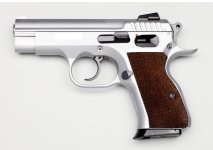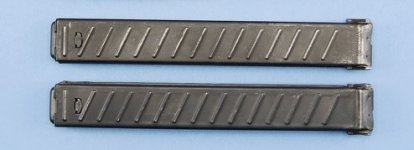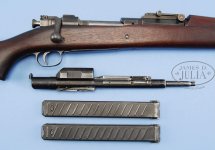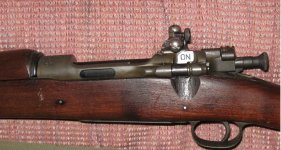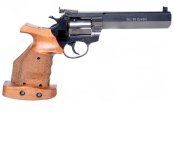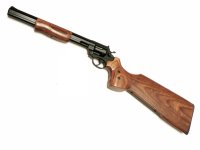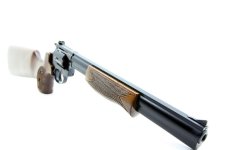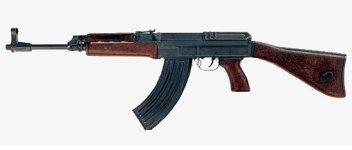DubC-Hicks got it. Great call.
#29 M1944 Hyde Carbine
https://en.wikipedia.org/wiki/M1944_Hyde_Carbine
Hyde quick change barrel carbine #29
The M1944 Hyde Carbine was an attempt by George Hyde to manufacture a light rifle for the US Armed Forces. The overall weapon was based on the Thompson Submachine Gun which Hyde himself designed many of his weapons on.
Although an original .30 Carbine calibre platform was based on the M1921/27 variants, It worked well but due to the war effort was found expensive for mass production and its weight defied the concept of a Light Rifle.[1]
The M1944 Hyde Carbine came with a quick barrel change device similar to the MG42[2] and pressed steel components to ease production/reduce weight. The M1944 Hyde Carbine was more reliable and accurate than the M1 Carbine that was adopted and also came with the capability of select fire, which made it close to the likes of the StG-44.
While an obvious copy of the MG42 (which then had only been produced for two years), it was dubious why a quick-change barrel was necessary on a submachine gun. The bolt has the rat-tail, similar to a Solothurn MP-34, where the spring is contained within the buttstock. This is an interesting example of "making a gun out of sheetmetal" rather than "making a sheet metal gun". The Hyde gun may have been a mystery to some, but certainly not to readers of the first edition of The World’s Assault Rifles by Daniel Musgrave and Thomas B. Nelson, published in 1967 with the photos seen there.
George Hyde is not a well recognized name, but was very active and involved in the American war effort. He was designing submachine guns as far back to 1933, and one of his guns (the Bendix-Hyde carbine) was entered in the Light Rifle trials which would eventually lead to the M1 Carbine. He also had a hand in the development of the Liberator pistol, designed the M2 submachine gun that was briefly adopted as a substitute standard, and designed (in cooperation with Inland’s Frederick W. Sampson) the M3 Grease Gun that replaced the Thompson in US military service.
Unfortunately, no known examples of the M1944 Hyde Carbine remain in existence. Immediately preceding U.S. entry into WWII, George Hyde also developed a series of .45 caliber submachineguns that superficially resembled a Thompson, initially with a finned barrel. He died about 1964. He is best remembered for his work on the M3 Grease Gun, and he is credited as the inventor of the system in which the bolt does not need to closely fit the stamped-metal receiver, but instead is guided by the recoil spring guide rods. This was later adapted to many other guns, notably the AR-18 and the Ultimax 100.
#29 M1944 Hyde Carbine
https://en.wikipedia.org/wiki/M1944_Hyde_Carbine
Hyde quick change barrel carbine #29
The M1944 Hyde Carbine was an attempt by George Hyde to manufacture a light rifle for the US Armed Forces. The overall weapon was based on the Thompson Submachine Gun which Hyde himself designed many of his weapons on.
Although an original .30 Carbine calibre platform was based on the M1921/27 variants, It worked well but due to the war effort was found expensive for mass production and its weight defied the concept of a Light Rifle.[1]
The M1944 Hyde Carbine came with a quick barrel change device similar to the MG42[2] and pressed steel components to ease production/reduce weight. The M1944 Hyde Carbine was more reliable and accurate than the M1 Carbine that was adopted and also came with the capability of select fire, which made it close to the likes of the StG-44.
While an obvious copy of the MG42 (which then had only been produced for two years), it was dubious why a quick-change barrel was necessary on a submachine gun. The bolt has the rat-tail, similar to a Solothurn MP-34, where the spring is contained within the buttstock. This is an interesting example of "making a gun out of sheetmetal" rather than "making a sheet metal gun". The Hyde gun may have been a mystery to some, but certainly not to readers of the first edition of The World’s Assault Rifles by Daniel Musgrave and Thomas B. Nelson, published in 1967 with the photos seen there.
George Hyde is not a well recognized name, but was very active and involved in the American war effort. He was designing submachine guns as far back to 1933, and one of his guns (the Bendix-Hyde carbine) was entered in the Light Rifle trials which would eventually lead to the M1 Carbine. He also had a hand in the development of the Liberator pistol, designed the M2 submachine gun that was briefly adopted as a substitute standard, and designed (in cooperation with Inland’s Frederick W. Sampson) the M3 Grease Gun that replaced the Thompson in US military service.
Unfortunately, no known examples of the M1944 Hyde Carbine remain in existence. Immediately preceding U.S. entry into WWII, George Hyde also developed a series of .45 caliber submachineguns that superficially resembled a Thompson, initially with a finned barrel. He died about 1964. He is best remembered for his work on the M3 Grease Gun, and he is credited as the inventor of the system in which the bolt does not need to closely fit the stamped-metal receiver, but instead is guided by the recoil spring guide rods. This was later adapted to many other guns, notably the AR-18 and the Ultimax 100.

